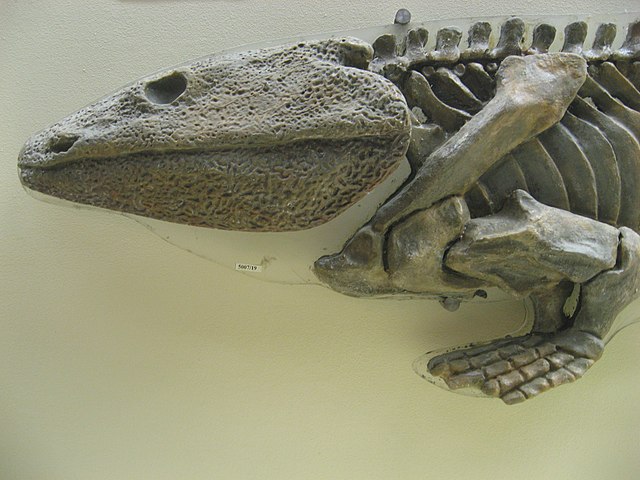Ichthyostega is an extinct genus of limbed tetrapodomorphs from the Late Devonian of what is now Greenland. It was among the earliest four-limbed vertebrates ever in the fossil record and was one of the first with weight-bearing adaptations for terrestrial locomotion. Ichthyostega possessed lungs and limbs that helped it navigate through shallow water in swamps. Although Ichthyostega is often labelled a 'tetrapod' because of its limbs and fingers, it evolved long before true crown group tetrapods and could more accurately be referred to as a stegocephalian or stem tetrapod. Likewise, while undoubtedly of amphibian build and habit, it is not a true member of the group in the narrow sense, as the first modern amphibians appeared in the Triassic Period. Until finds of other early stegocephalians and closely related fishes in the late 20th century, Ichthyostega stood alone as a transitional fossil between fish and tetrapods, combining fish and tetrapod features. Newer research has shown that it had an unusual anatomy, functioning more akin to a seal than a salamander, as previously assumed.

Ichthyostega
Skull A.199, Zoological Museum of Copenhagen
Tail with fin rays, counterpart of specimen A.69
Tetrapodomorpha is a clade of vertebrates consisting of tetrapods and their closest sarcopterygian relatives that are more closely related to living tetrapods than to living lungfish. Advanced forms transitional between fish and the early labyrinthodonts, such as Tiktaalik, have been referred to as "fishapods" by their discoverers, being half-fish, half-tetrapods, in appearance and limb morphology. The Tetrapodomorpha contains the crown group tetrapods and several groups of early stem tetrapods, which includes several groups of related lobe-finned fishes, collectively known as the osteolepiforms. The Tetrapodomorpha minus the crown group Tetrapoda are the stem Tetrapoda, a paraphyletic unit encompassing the fish to tetrapod transition.
Image: Megalichthys NT
Image: Extant tetrapoda





